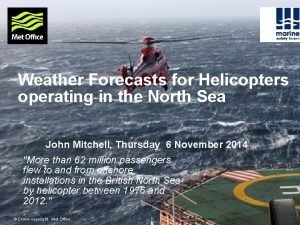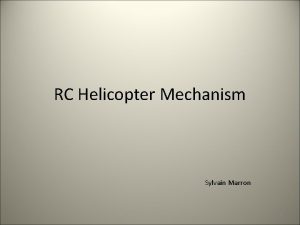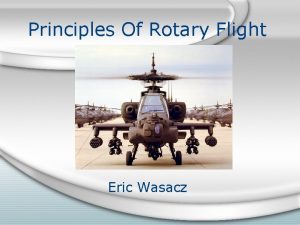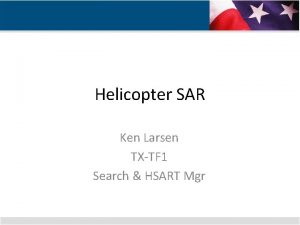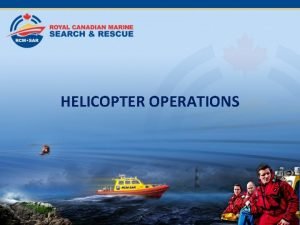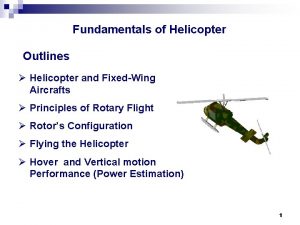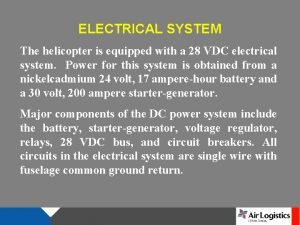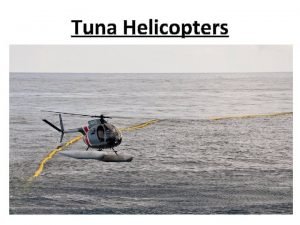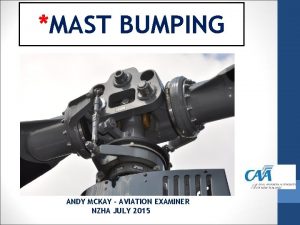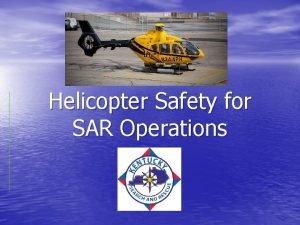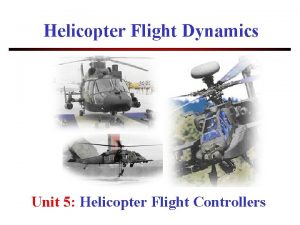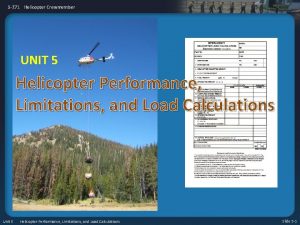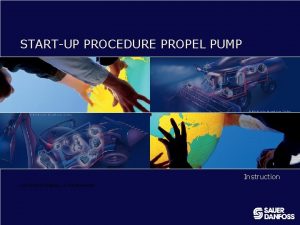Lesson 13 Propel me In a helicopter you














- Slides: 14

Lesson 13 Propel me

In a helicopter, you can move in any direction or you can rotate 360 degrees

How do helicopters work? The wings of a normal airplane obtain upward lift forces from the air as the airplane moves forward through the air. That's because the shape and angle of the wings is such that air flows faster over the top surface of each wing than under the bottom surface. A helicopter spins its wings around in a circle so that they move through the air even when the helicopter itself is stationary. Normally, these rotating wings are called blades. Again, the air flows faster over each blade than beneath it and there is a net upward pressure force on each blade. These upward forces support the helicopter and they also allow it to tilt itself--by adjusting the angle of each blade as the blades turn, the helicopter can obtain twists from the air so accelerates forward, backward, or toward the side.


The Main Rotor A helicopter's main rotor is the most important part of the vehicle. It provides the lift that allows the helicopter to fly, as well as the control that allows the helicopter to move laterally, make turns and change altitude. To handle all of these tasks, the rotor must first be incredibly strong. It must also be able to adjust the angle of the rotor blades with each revolution of the hub. The adjustability is provided by a device called the swash plate assembly.

The swash plate assembly consists of two plates -- the fixed and the rotating swash plates shown above in blue and red, respectively. • The rotating swash plate rotates with the drive shaft (green) and the rotor's blades (grey) because of the links (purple) that connect the rotating plate to the drive shaft. • The pitch control rods (orange) allow the rotating swash plate to change the pitch of the rotor blades. • The angle of the fixed swash plate is changed by the control rods (yellow) attached to the fixed swash plate. • The fixed plate's control rods are affected by the pilot's input to the cyclic and collective controls. • The fixed and rotating swash plates are connected with a set of bearings between the two plates. These bearings allow the rotating swash plate to spin on top of the fixed swash plate.

The collective lets you change the angle of attack of the main rotor simultaneously on both blades. The cyclic changes the angle of attack of the main rotor's wings unevenly by tilting the swash plate assembly. On one side of the helicopter, the angle of attack (and therefore the lift) is greater.

The Forces At Work There are many forces at work when a helicopter flies, and many are specific to helicopter flight. We all have learnt about: lift, drag, gravity, and thrust In order to spin the shaft with enough force to lift a human being and the vehicle, you need an engine. This arrangement works really well until the moment the vehicle leaves the ground. At that moment, there is nothing to keep the engine (and therefore the body of the vehicle) from spinning just like the main rotor does. So, in the absence of anything to stop it, the body will spin in an opposite direction to the main rotor. To keep the body from spinning, you need to apply a force to it. The usual way to provide a force to the body of the vehicle is to attach another set of rotating wings to a long boom. These wings are known as the tail rotor. The tail rotor produces thrust just like an airplane's propeller does. By producing thrust in a sideways direction, counteracting the engine's desire to spin the body, the tail rotor keeps the body of the helicopter from spinning. The tail rotor has a 6 to 1 rotational ratio to the main rotor system.

Autorotation Most people think that a helicopter will fall like a rock and the rotor system will stop once the engine fails. This is a totally false assumption. A helicopter can continue to fly without any power from the engine. "Autorotation" is the term used for "Gliding" a helicopter down after the engine fails or the throttle is retarded to the idle position. If you look at a rotor blade from the tip of the blade toward the root, you will see it will twist laterally. At the tip of the blade, the leading edge may point down while at the root of the blade, the leading edge may point up. This allows different regions of the blade to perform different tasks, one of which is Autorotation. The outer portion of the blade, when the collective is lowered all the way to what is called "Flat Pitch", will drive the rotor system as the aircraft glides downward, increasing or maintaining the speed of the rotor system. The rotor system is driven normally by a centrifugal clutch which is positively engaged while the engine supplies power, but disengages when power is removed. The rotor system "Free Wheels", and continues to spin. The air travelling upward through the rotor system continues to drive the system and maintain rotor RPM.

Notes

A rotary motion is the easiest way to keep a wing in continuous motion. So you can mount two or more wings on a central shaft and spin the shaft, much like the blades on a ceiling fan. The rotating wings of a helicopter are shaped just like the airfoils of an airplane wing, but generally the wings on a helicopter's rotor are narrow and thin because they must spin so quickly. The helicopter's rotating wing assembly is normally called the main rotor. If you give the main rotor wings a slight angle of attack on the shaft and spin the shaft, the wings start to develop lift. In order to spin the shaft with enough force to lift a human being and the vehicle, you need an engine of some sort. Reciprocating gasoline engines and gas turbine engines are the most common types. The engine's driveshaft can connect through a transmission to the main rotor shaft. This arrangement works really well until the moment the vehicle leaves the ground. At that moment, there is nothing to keep the engine (and therefore the body of the vehicle) from spinning just like the main rotor does. So, in the absence of anything to stop it, the body will spin in an opposite direction to the main rotor. To keep the body from spinning, you need to apply a force to it. The usual way to provide a force to the body of the vehicle is to attach another set of rotating wings to a long boom. These wings are known as the tail rotor. The tail rotor produces thrust just like an airplane's propeller does. By producing thrust in a sideways direction, counteracting the engine's desire to spin the body, the tail rotor keeps the body of the helicopter from spinning. Normally, the tail rotor is driven by a long drive shaft that runs from the main rotor's transmission back through the tail boom to a small transmission at the tail rotor. What you end up with is a vehicle that looks something like this:

INTELLIGENT IGNORANCE Desire can create 'Intelligent Ignorance' and with this a lot of things can happen. You've no doubt heard the story about the bumble bee. It's a classic example of what intelligent ignorance is all about. If you have done any reading into the science of aerodynamics you will know that the bumble bee cannot fly. His body is too heavy and his wings are too light. It is impossible for him to fly. But you see the bumble bee doesn't read - the bumble bee flies! Henry Ford was a classic case of intelligent ignorance. He was a man with a limited education. He had made a fortune with the Model T and then the Model A and then one day he had a wild idea. He conceived an idea of building a V 8 engine. Mr. Ford was not an engineer so he called his highly paid staff together and said "Gentlemen, I want you to build me a V 8 engine". They explained to him in no uncertain terms that the V 8 was an engineering impossibility, that it couldn't be done. He said "Well, I understand that, but we've got to have one, and I want you to build one. What's more I want you to build it right now!" The story goes that they spent quite a few dollars making a half-hearted effort and came back a few months later to say to Mr. Ford, "Like we said Mr. Ford, the V 8 is an impossibility - it cannot be done. " Mr Ford said, "Gentlemen, obviously you don't understand. We've got to have a V 8 engine and you've got to build one, so go build it!" Well this time the engineers went out and they spent a little more money and they stayed a little longer. They finally came back and said "Mr. Ford, it just can't be done. " This time Mr. Ford hit the ceiling! He said "Gentlemen, obviously I am not communicating my message to you. The V 8 engine is going to be built and you're going to build it for me. So go out there, and this time I don't want you to come back until you tell me the news you know I want to hear! You are going to build a V 8 engine". They built the V 8 engine! Henry Ford had that intelligent ignorance. He once said, "I'm looking for a lot of men with an infinite capacity for not knowing what can't be done. " We need more people who don't know what can't be done. They are the ones who will go out there and do it. Henry Ford had the desire! Find your desire, set your goals, take action - and make your dreams a reality

It takes both hands and both feet to fly a helicopter! One hand grasps a control called the cyclic, which controls the lateral direction of the helicopter (including forward, backward, left and right). The other hand grasps a control called the collective, which controls the up and down motion of the helicopter (and also controls engine speed). The pilot's feet rest on pedals that control the tail rotor, which allows the helicopter to rotate in either direction on its axis.

 Propel php tutorial
Propel php tutorial Dangerous propel lacrosse
Dangerous propel lacrosse Propel marketing
Propel marketing Helicopter weather forecast
Helicopter weather forecast How many syllables in phenomenon
How many syllables in phenomenon Rc helicopter governor
Rc helicopter governor How helicopter moves forward
How helicopter moves forward Helicopter short haul equipment
Helicopter short haul equipment Helicopter winching area marking
Helicopter winching area marking How do helicopters move forward
How do helicopters move forward Helicopter electrical system
Helicopter electrical system Tuna boat helicopter
Tuna boat helicopter Mast-bumping
Mast-bumping Makalu gau frostbite
Makalu gau frostbite Helicopter history timeline
Helicopter history timeline



